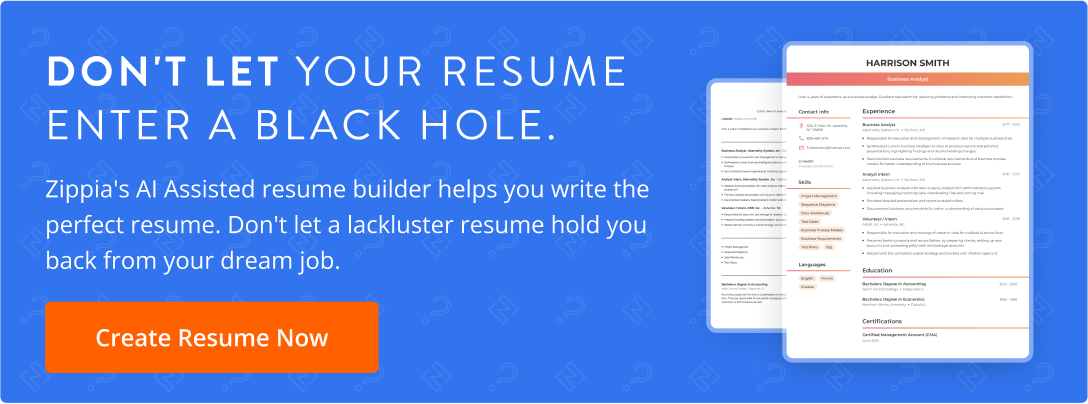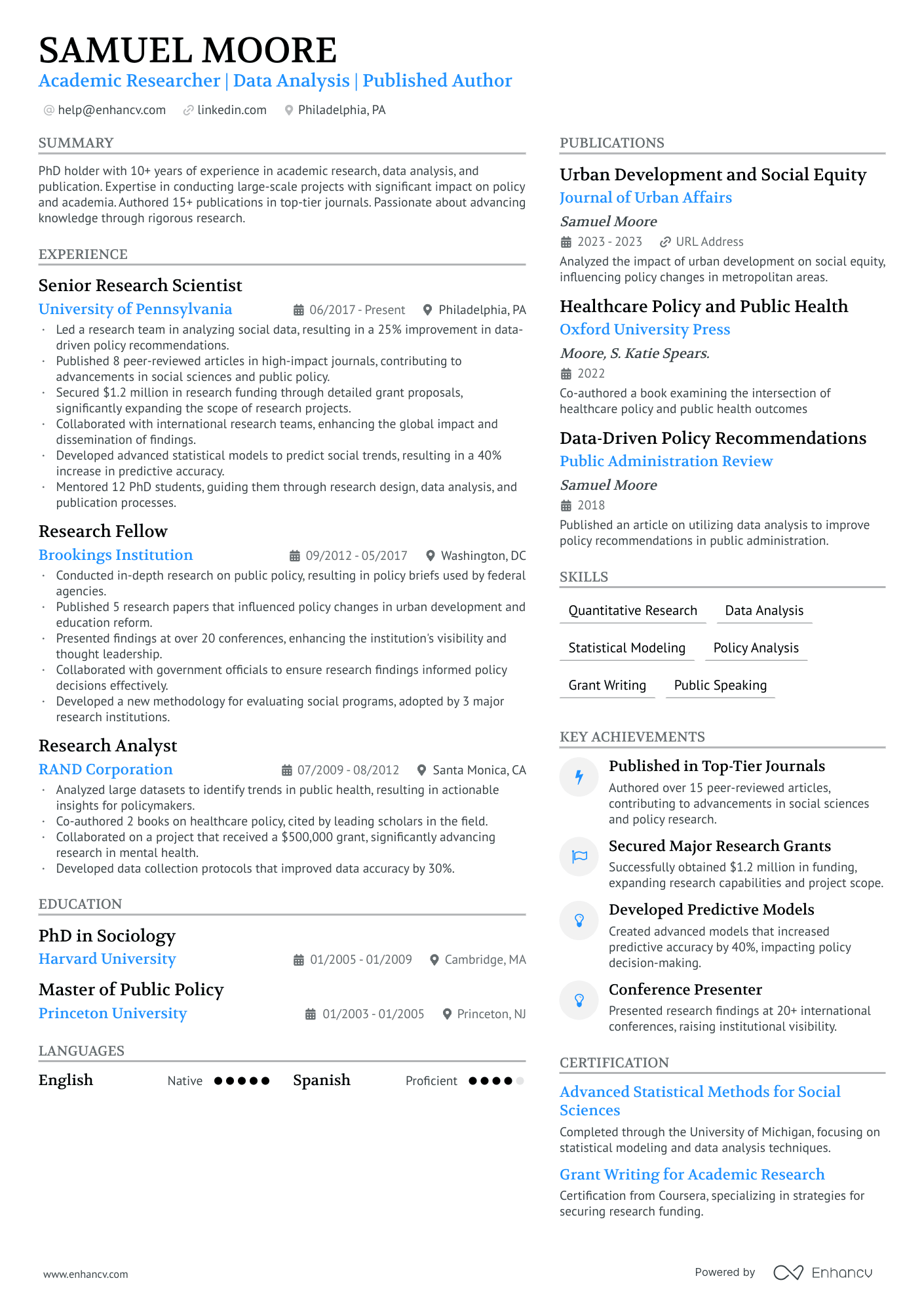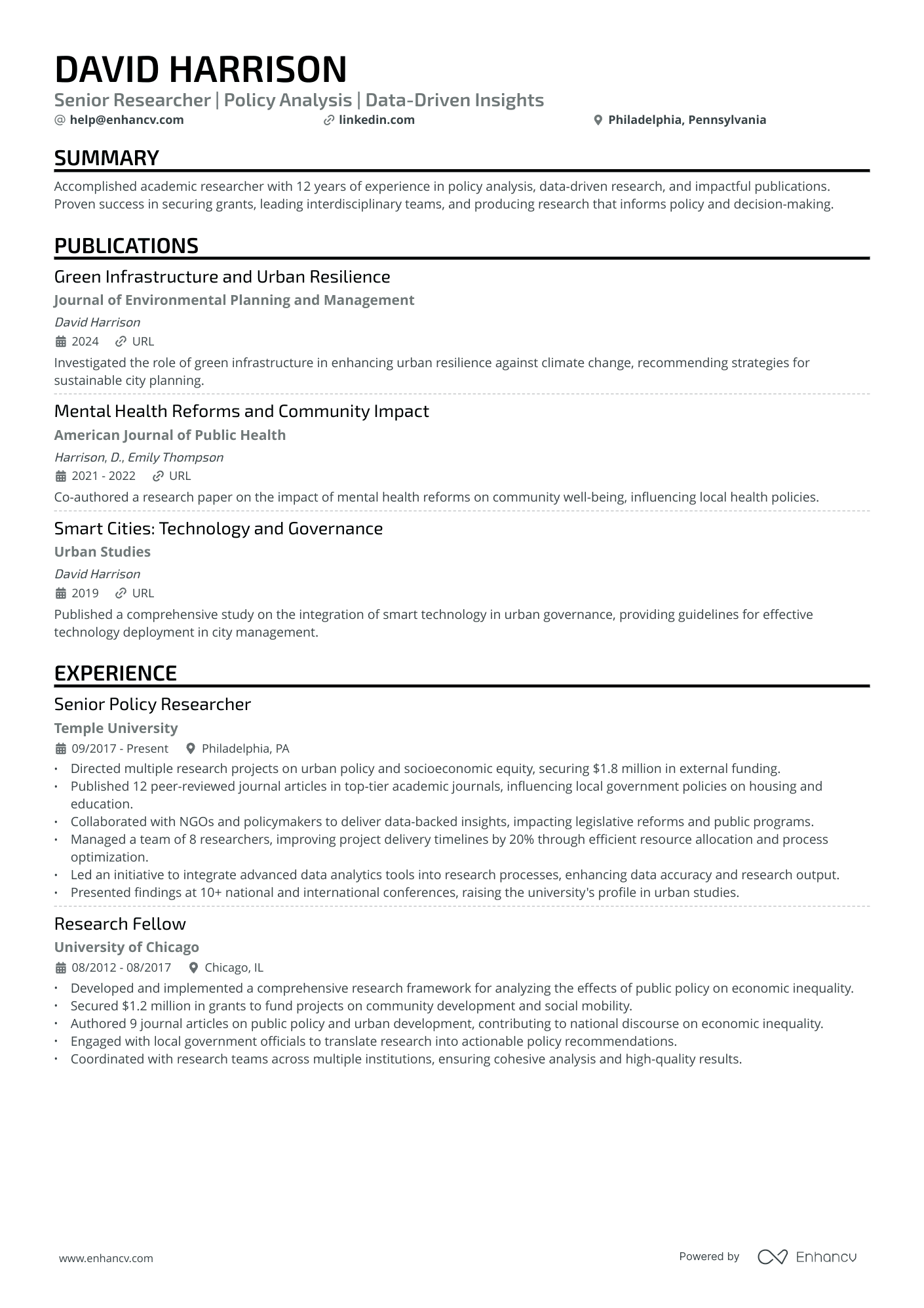Explore Jobs
- Jobs Near Me
- Remote Jobs
- Full Time Jobs
- Part Time Jobs
- Entry Level Jobs
- Work From Home Jobs
Find Specific Jobs
- $15 Per Hour Jobs
- $20 Per Hour Jobs
- Hiring Immediately Jobs
- High School Jobs
- H1b Visa Jobs
Explore Careers
- Business And Financial
- Architecture And Engineering
- Computer And Mathematical
Explore Professions
- What They Do
- Certifications
- Demographics
Best Companies
- Health Care
- Fortune 500
Explore Companies
- CEO And Executies
- Resume Builder
- Career Advice
- Explore Majors
- Questions And Answers
- Interview Questions

How To Put Research On Your Resume (With Examples)
- How To Write A Resume
- How To Build A Resume
- Specific Resume Words
- Action Verbs On A resume
- Words To Describe Yourself
- Resume Outline
- How To Make A Resume
- How To Make A Resume On Word
- How To Write A Resume Profile
- General Resume Examples
- Resume With No Experience
- Student Resume
- College Resume
- Entry Level Resume
- Military Resume
- Internship Resume
- First Resume
- College Application Resume
- 2 Page Resume
- Blank Resume Template
- College Freshman Resume
- Work History
- Resume Templates
- Resume Tips
- Best Resume Writing Services
- Things To Avoid On A Resume
- Resume Paper To Use
- What To Include In A Resume
- How To Write A Bio
- How To Write A Personal Statement
- Lied on Your Resume?
- Avoid Age Discrimination
- Words and Phrases You Shouldn't Include in Your Resume
- How Many Skills Should You List On A Resume
- Send A Resume As A Pdf
- Resume Critique
- Make A Resume Stand Out
- Resume Spelling
- Resume Past Or Present Tense
- How To List Projects On A resume
- Best Resume Action Words
- How To Quantify Your Resume
- Resume Bullet Points
- Are Resume Writers Worth It
- How Many Jobs To List On Resume
- Please Find Attached My Resume
- How To List Contract Work On Your Resume
- How To Put Research On Your Resume
- What Is A CV?
- CV Vs Resume
- CV Templates
- CV Examples
Find a Job You Really Want In
Research experiences and skills are an incredibly important aspect of many job applications, so it’s important to know how to put them on your resume correctly. Hiring managers and recruiters want employees who can help drive innovation by being able to apply research skills to problem solve and come up with creative growth solutions. If you’re a job seeker looking to include your research skills on a resume , we’ll go over how to list research on resume, where you can include it on a resume, and give you some examples. Key Takeaways: If you don’t have traditional research experience, highlight the skills used for research that you’ve used in past jobs. Consider creating a separate research section in your resume if you have a lot of research experience or merge sections, depending on which section you want to bolster with research. Research experience is one of the best assets to include on a resume so be on the lookout for more opportunities. In This Article Skip to section What are research skills? Where to put research experience on your resume How to include research on your resume Examples of research on a resume How to put research on your resume FAQ References Sign Up For More Advice and Jobs Show More What are research skills?
Research skills are any skills related to your ability to locate, extract, organize, and evaluate data relevant to a particular subject. It also involves investigation, critical thinking , and presenting or using the findings in a meaningful way.
Depending on what job you’re applying for, research skills could make or break your ability to land the job. Almost every job requires some research skills and you probably already have some of those skills mastered by now.
For most careers, research is a vital process to be able to answer questions. “Research skills” are not a single skill, but multiple ones put together.
Some skills that are necessary for research are organization, problem-solving, critical thinking, communication, and specific technical skills, like coding, Excel, and copywriting.
Where to put research experience on your resume
Including research experience and skills on a resume can be incredibly flexible. When thinking about how to add it to your resume, you want to consider how the research experience adds to your resume.
Your research experience can be included in a few different sections of your resume. Some of those sections include:
Academic accomplishments
Research experience
Work experience/history
College activities
Volunteer work
Presentations and publications
Skills section
If you’ve had smaller research roles but no “official” research experience, you can highlight the skills associated with the types of research mentioned above in your job description under the work history section in your resume.
If your job history is a research position, then naturally, you would include research under the work history section. You can also merge your sections depending on what type of position you are applying for.
For example, you could create a “Research and Education” section or a “Research and Publications” section. If your research is not related to your education and you don’t have any publications, you can also detail it in a separate “Research” section in your resume.
How to include research on your resume
To include your research on your resume, you should gather all the necessary information and then quantify your accomplishments to fit into specific sections. Here is a more detailed list of how to write about research experience in resume:
Gather all the necessary information. The first step is to collect all of the important details like the title of the research project, the location of the research project, the principal investigator of the project (if applicable), and the dates of the project. You will list these details much like you would list a company you have worked for in the past.
Read the job description carefully. Every resume and cover letter you write should be tailored to the job you’re applying for. When a hiring manager puts a necessary qualification in their job posting, you must be sure to include it in your resume.
Make sure that you highlight the right types of research skills on your job applications and resumes.
Quantify your accomplishments. When describing your role on the project, you will want to summarize your accomplishments and deliverables. Hiring managers and recruiters love seeing numbers. When you write out the deliverables from your project, make sure you quantify them.
Incorporate into your work history section. If there were times when you used your research skills in your past employment opportunities, include them in your work experience section. You can also include publications, conferences you may have presented at, and any awards or recognition your research had received.
If you have completed research in an academic setting, then presentations (oral and poster) are an important part of the research process. You should include those details along with the titles of your publications.
Add to your research section. Other aspects of research that you can detail to make your application more competitive are adding skills specific to your project to the skills section of your resume.
These skills will vary depending on the subject matter, but some examples include coding languages, interviewing skills, any software you used and are proficient in using, managerial skills , and public speaking if you have presented your research at conferences.
Add research to your skills section. If the specific research you did is less important than the skills you used to perform it, highlight that in your skills section. That way, you don’t have to take up a lot of work or education history with slightly irrelevant information, but hiring managers can still see you have research skills.
Just be sure you’re more specific about a research methodology you’re an expert in because the skills section doesn’t give you as much room to explain how you leveraged these abilities.
Sprinkle research throughout your resume. If you have a lot of experience performing research in professional, volunteer, and educational settings, pepper it in a few different sections. The more hands-on experience you have with research, the better (for jobs that require research).
Examples of research on a resume
Let’s look at some examples of how research can be included on a resume:
University research example
EDUCATION Undergraduate Thesis, University of Connecticut, Dec. 2017-May 2018 Worked alongside UCONN English Department head Penelope Victeri to research the poetry of New England writers of the 20th century. Explored common themes across the works of Elizabeth Bishop, Wallace Stevens, and Robert Lowell. Performed online and in-person research on historical documents relating to each author , including information on the political, religious, and economic landscape of the US at the time. Analyzed poetic works of each author and drew on similar contemporary regional authors’ works. Prepared 20,000 words thesis entitled “Place, Allegory, and Religion: Three 20th Century New England Poets” and defended my written arguments to a panel of English professors.
Customer service research example
WORK EXPERIENCE Conducted interviews with 20 customers each week to gain insight into the user experience with company products Used Google analytics to determine which pages were driving most web traffic, and increased traffic by 11% Reviewed thousands of customer surveys and compiled findings into monthly reports with graphic findings Presented at weekly marketing meeting to inform marketing team of trends in customer experience with our products
Laboratory research example
RESEARCH Conducted experiments on rat brains by introducing various novel chemical compounds and levels of oxygen Ran electricity through brain slices to view interaction of different chemical compounds on active brain cells Prepared sterile samples for daily check and maintained 89% percent yield over the course of a 3-month study Presented findings in a final 15 -page research report and presentation to the Research and Development team
Examples of common research skills to list on your resume
Here are examples of research skills in action that you may have overlooked:
Searching for local business competition
Sending out customer satisfaction surveys
Summarizing current policies and laws in effect for a particular topic
Creating lesson plans based on current education standards
Reading literature reviews and implementing changes in clinical practice
Attention to detail
Problem-solving skills
Critical thinking
Project management skills
Communication skills
How to put research on your resume FAQ
Why are research skills important?
Research skills are important because they can help you identify a problem, gather information, and evaluate that information for relevancy. Including your research skills on a resume will show hiring managers that you have the ability to suggest new ideas and help their organization adapt and change as the industry changes.
What are research skills?
Some common research skills include:
critical thinking
Computer skills
Can I list research as a skill?
Yes, you can list research as a skill on your resume. Including your research skills in your resume can help show a potential employer that you have the ability to suggest new ideas and use critical thinking to find solutions to problems. Most research skills will use attention to detail, problem-solving, and project management skills.
California State University San Bernardino – Incorporating Research Project Experience on Your Resume
University of Missouri – How to Put Research on Your Resume
How useful was this post?
Click on a star to rate it!
Average rating / 5. Vote count:
No votes so far! Be the first to rate this post.

Heidi Cope is a former writer for the Zippia Career Advice blog. Her writing focused primarily on Zippia's suite of rankings and general career advice. After leaving Zippia, Heidi joined The Mighty as a writer and editor, among other positions. She received her BS from UNC Charlotte in German Studies.

Related posts

30 Things You Need To Know About North Carolina Before You Start Working There

How to Respond to a Job Rejection Email (With Examples)

Trade School Vs College: Choosing The Right Career Path For You

How To Answer Behavioral Interview Questions (With Examples)
- Career Advice >
- Get The Job >
- How To Put Research On Resume Research Experience

How to List Publications on a Resume (with Examples)
Written by Gabriela Manova
Content Writer and Editor
In This Guide:
What are publications, why include publications on a resume, how to list publications, where to list publications on a resume, common mistakes to avoid, faqs about publications on a resume.

You might think a publications section on a resume is reserved solely for those in research or academia. However, it's incredibly beneficial for anyone whose main accomplishments are illustrated through their written work. Whether you're a writer, journalist, therapist, or even a business professional, listing your publications can significantly enhance your resume by underlining your expertise and contributions to your field.
However, crafting an effective publications section can be tricky. How do you decide which pieces to include? How should you format them? And how can you make sure they stand out to hiring managers who might skim past them? Let's break down the main challenges and offer some straightforward solutions to ensure your publications shine on your resume.
Key takeaways:
- The publications section on a resume is particularly relevant for roles in research, academia, journalism, writing, and PhDs across various fields.
- Your published work can include books, papers, and peer-reviewed articles but can also encompass website publications, blog posts, and other non-traditional formats. Tailor your selection based on the specific requirements of your field and role.
- Including publications on a resume enhances your credibility and strengthens your application by underlining your expertise, making it highly valuable in certain professional contexts.
- You can list your publications in a dedicated section (the more common approach) or integrate them into the education section of your resume.
- Maintain a consistent citation style throughout your publications list to ensure professionalism and clarity.
- Avoid common pitfalls, such as providing excessive detail or listing publications that aren’t relevant.
Publications, also called academic publishing, distribute academic research and scholarship. Most of this work is published in academic journal articles, books, or thesis forms. Most scientific and scholarly journals, and many academic and scholarly books, though not all, are based on some form of peer review or editorial refereeing to qualify texts for publication.
Consider including a publications section on your resume if you’re pursuing research-intensive or academic roles. It’s also a good idea to place such a section if writing is an integral part of your work, as publications can give greater credibility to your application.
What counts as a peer-reviewed publication?
A peer-reviewed publication is also sometimes referred to as a scholarly publication. Peer-reviewed publications are articles, scholarly works, research, or ideas written by experts and reviewed by several other experts in the field before being published in a journal to ensure their quality.
Do blog posts count as publications?
Avoid listing blog posts published in magazines or nonscientific publications. If your thesis wasn’t published in a journal, better list it in the “Education” section of your resume/CV.
Do website articles count as a publication?
Including website articles, even if they’re not peer-reviewed, is a great way for a marketer or a copywriter to show their expertise and writing aptness.
However, when you’re applying to a strictly academic position, be cautious only to include publications and articles from industry journal publications and trade association websites.
Including publications on a resume is usually done for three main reasons:
- It’s relevant to the job.
- Demonstrates proficiency and authority.
- Employers value publications as a sign of expertise and research skills.
Let’s briefly review each of these options.
Relevance to the job/field
Who benefits from listing publications on their resume the most?
- Research positions: In industries like biotech, pharmaceuticals, environmental science, and engineering—research publications can set candidates apart by showing their ability to conduct and report on critical investigations.
- Academic positions: For roles in academia, including professorships, researcher roles , and even postgraduate admissions—publications are often a requirement rather than a bonus. They demonstrate your contribution to the field and your ongoing engagement with cutting-edge research.
- Content writing , copywriting , journalism : Publications in reputable magazines, journals, or online platforms can be particularly beneficial for professionals in these fields. They underline your ability to engage audiences, craft compelling narratives, and maintain a high standard of language and content quality.
Demonstrating expertise and authority
This might be self-explanatory, but publications in well-regarded outlets are a testament to your writing skills and ability to appeal to broad or specific audiences.
Contributing to major industry publications or influential blogs can also cement your status as an expert in a particular niche or subject area. Including descriptions of the content, target audience, and any notable feedback or outcomes (like awards or recognitions) can emphasize the impact and reach of your work.

Significance to employers
Your publications reflect active participation in industry discussions, networking within media circles, and your potential to influence through written work. They also demonstrate your ability to produce engaging, well-researched content, crucial for roles in media and communications.

Make this your resume
Use Enhancv’s Resume Builder and make a resume that stands out.
In this section, we’ll guide you on how to format your publications effectively, with easy-to-follow examples and tips to make sure your achievements stand out clearly and professionally. Use these general tips to ease your process:
- Title the section appropriately: Use a clear, professional title for the section such as “Publications,” “Research Publications,” or “Selected Publications” if you choose to list only the most relevant or prestigious ones.
- Format consistently: List each publication in a consistent format. Choosing the right citation style for your resume’s publication list is important, as there’s no one-size-fits-all format. Different academic fields and institutions have their own specific rules.
- Categorize if necessary: If you have a large number of publications, consider subdividing them into categories such as “Journal Articles,” “Conference Proceedings,” and “Books” to enhance readability and organization.
- Emphasize key publications: If certain publications are highly relevant to the job you're applying for, consider highlighting them by placing them at the top of the list or providing a brief explanation of why they’re relevant.
Citation styles
Here are examples of the most common citation styles:
The most common citation styles are:
- APA (American Psychological Association)—used by Education, Psychology, and Sciences.
- MLA (Modern Language Association)—used by the Humanities.
- Chicago—generally used by Business, History, and the Fine Arts.
APA format example
The APA format typically includes the author’s last and first names, publication year, article title, volume and issue number, page range, and DOI (if available).
Doe, J. (2023). Understanding Citation Styles. Journal of Academic Resources , 15(4), 123-135. https://doi.org/xx.xxx/yyyy
MLA format example
The MLA format generally requires the author's name, article title, journal title, volume and issue number, publication year, page range, and URL or DOI.
Doe, John. “Understanding Citation Styles.” Journal of Academic Resources , vol. 15, no. 4, 2023, pp. 123-135, www.journalwebsite.com/fullarticle.
Chicago format example
Chicago style can be presented in a note and a bibliographic entry, focusing on the author's name, article title, journal title, volume, issue, year of publication, page range, and accessed URL or DOI.
Doe, John. 2023. “Understanding Citation Styles.” Journal of Academic Resources 15, no. 4 (April): 123-135. https://doi.org/xx.xxx/yyyy.
Note that different academic institutions might have their own stylistic requirements.
How to list publications on an academic CV
Crafting an academic resume or CV that effectively displays your scholarly achievements is crucial, especially when focusing on your publications. This element of your CV not only reflects your research capabilities but also your impact within your field.
Here’s how to structure your publications section efficiently:
- Categorization : Organize your publications into relevant sections such as journal articles, conference papers, books, and book chapters to enhance navigability and emphasis on specific types of work.
- Detail and consistency : Use a consistent citation format appropriate for your discipline. Include all authors, publication year, titles, and publication details. Consider bolding your name to highlight your contributions to collaborative works.
- Chronological order : List your publications in reverse chronological order to immediately draw attention to your most recent scholarly work.
- Descriptors : For key publications, include a brief note on the significance or impact of the work, such as any awards won or significant citations it has garnered.
Is your resume good enough?
Drop your resume here or choose a file . PDF & DOCX only. Max 2MB file size.
When deciding where to list publications on a resume, it's important to consider how they align with your overall professional profile and the specific job you’re applying for.
Here’s a deeper look into the most common approaches.
Listing your publications in a separate section
This might be the best approach to give your publications the importance they deserve. It’s especially helpful if you’ve got numerous or particularly prestigious publications you want to draw recruiters’ attention to.
Here’s an example publications section created with the Enhancv resume builder :
This entry emphasizes key publications, following consistent formatting. It’s titled appropriately and includes all the relevant information for potential employers.
Listing your publications in the education section
Incorporating publications into the education section can be effective if you have only a few publications, if your work’s not been peer-reviewed, or if publications aren’t the main focus of your work.
Here’s how to integrate them:
- • Thesis on 'Innovative Strategies in Digital Marketing'—explored the impact of digital platforms on consumer behavior.
- • Published 'The Role of Analytics in Strategic Decision-Making' in Business Horizons, 2001
When adding publications to the education section of a resume for roles like business consulting, it’s key to select ones that are relevant to the job. Calling attention to these publications can enhance a candidate's profile by demonstrating their knowledge and thought leadership.
The publications should complement, not overshadow, the educational details, subtly boosting the candidate's expertise and credibility.
Here are some common mistakes to avoid in the publications section of a resume:
- Lack of detail : Simply listing the title of your publication without context or details can be confusing for the reader. Include relevant information such as co-authors, the date of publication, and the name of the journal or conference.
- Overwhelming information : While it’s important to provide details, too much information can overwhelm the reader. Avoid including every single publication if you have many. Instead, select the most relevant or prestigious publications.
- Inconsistent formatting : Consistency in formatting is key. Choose a citation style and use it across all entries. This makes your list easier to read and more professional.
- Not prioritizing : Place your most impressive or relevant publications at the top. If you’re applying for a research position, highlight your peer-reviewed papers over articles or presentations.
- Inaccuracies : Double-check for any inaccuracies in your citations . Incorrect information can be seen as a lack of attention to detail and can question your credibility.
- Ignoring authorship order : Especially in fields where the order of authors is significant, mention your specific role or contribution if it adds value to your application and isn't clear from the author list.
- Neglecting to link to publications : If applicable, provide URLs or DOIs for your publications. This allows employers or committee members to easily access and review your work.
- Omitting publications under review : If you have significant works under review or in the press, consider including these to show ongoing research activity. Mark these as “under review” or “in press.”
- Forgetting non-traditional publications : If relevant, include non-traditional publications such as blogs, industry articles, or major presentations. These can demonstrate expertise and communication skills.
- Using technical jargon : If applying outside of academia or your specific field, minimize technical jargon in your descriptions. Make it accessible to non-specialists who might read your resume.

How should I list confidential publications?
When you've worked on confidential projects, you might struggle with how to list these publications on your resume without revealing sensitive information. One strategy is to use generalized descriptions that focus on the type of research and the skills you employed without detailing the confidential aspects.
For instance, you might list a publication as “Article on proprietary algorithm optimization for a leading fintech company.” This way you get to show your expertise while respecting confidentiality agreements.
How many publications to list?
The number of publications to include on your resume should be guided by their relevance to the job you’re applying for and the space available on your resume. If space is limited, prioritize newer publications that are most relevant to the position. It's generally better to list fewer, more relevant publications than to fill your resume with everything you've done.
Highlight publications that have had a significant impact or are prestigious within your field. Select works that underscore your depth of knowledge, research skills, and any notable collaborations. This selective approach directs the employer’s attention to your most impressive achievements.
How to list pending publications on a resume?
It's acceptable to list works that are under review or forthcoming as long as they’re marked as such. You can list these publications under a separate subheading titled “Forthcoming Publications” or “Manuscripts Under Review,” and include expected publication dates if available. Or, you could simply add an expected publication date in brackets when listing the publication in your respective “Publications” section. This demonstrates your ongoing commitment to your field and keeps your resume current.
Can I put a manuscript in preparation on my resume?
Yes, manuscripts in preparation can be listed to show forthcoming work and ongoing research activities. Label them clearly as “in preparation” to set proper expectations regarding their status.
How to include a digital portfolio on a resume?
Including links to your digital portfolio, personal website, or academic profiles like Google Scholar and ResearchGate can enhance your resume. These links provide direct access to your body of work and can be particularly useful for roles that value research and publications.
An interesting way to link directly to your publications or professional profiles is through QR codes or URLs. This makes it easier for employers to access your work. Ensure that these links are short, readable, and professional.
How to handle older publications?
When considering whether to include older publications, assess their relevance to the position you're applying for. If they demonstrate longstanding expertise or were particularly influential, they might be worth including.
Consider creating an appendix or a separate document where these can be archived. This way, they’re still accessible to those who are interested without cluttering your main resume.
Does a review count as a publication?
Reviews can be included as publications on your resume, especially if they’re peer-reviewed or published in reputable journals. They demonstrate your depth of knowledge and ability to critically engage with your field.
What is the difference between a resume and a CV?
The main differences between a resume and a CV (Curriculum Vitae) are length, purpose, and content. A resume is generally a one-page summary tailored to specific job roles, emphasizing relevant skills and experiences, making it suitable for most job applications in the U.S. and Canada.
A CV, however, is more detailed and without page restrictions, covering one’s entire academic and professional history, including teaching and research experience, publications, and awards, typically required for academic, research, or scientific positions, or jobs in certain countries outside North America.
Listing publications on your resume is more than a mere catalog of your work–it's a strategic display of your professional journey and intellectual contributions. By carefully selecting relevant pieces, maintaining a clear format, and adapting to the specific expectations of your field, you can turn this section into a powerful testament to your expertise and a standout feature in your job applications.

Resume Guides
How to answer the "what do you least like about your job" interview question, should i put my linkedin url on my resume, can you count internships as work experience yes, and here's why., how to list ged on your resume, how to answer the “what are your compensation expectations” interview question, resume length: how long should a resume be in 2025.

IMAGES
VIDEO
COMMENTS
Dec 10, 2024 · Related: 23 Research Databases for Professional and Academic Use If you want to list publications on a resume, you can take a simpler approach: Create a dedicated section. Add a component to your resume page titled “Publications.” Use reverse chronological order.
Aug 14, 2023 · Yes, you can list research as a skill on your resume. Including your research skills in your resume can help show a potential employer that you have the ability to suggest new ideas and use critical thinking to find solutions to problems. Most research skills will use attention to detail, problem-solving, and project management skills. References
Dec 16, 2020 · Here are ways to include publications on your resume: 1. Create a separate research and publications section. One way to list your published works is to create a separate section for them on your resume. Use this method if you have a few publications. This method is ideal for people who have been published in respectable industry publications.
Nov 4, 2024 · Here’s how to add it: How to List Research on Resumes. Add research to your resume after your experience and education sections. If you have a lot of it and it’s relevant to the job, put it in a special section called “research.” List each research project in a different bullet point.
Resumés are important documents for all kinds of application packages -- jobs, scholarships, grad school, etc. Your resumé should fit within the total package highlighting your achievements in a concise manner that can be further expounded upon in your personal statement, cover letter, or your letters of reference. It is important to custom tailor your…
Mar 26, 2021 · The publications section on a resume is particularly relevant for roles in research, academia, journalism, writing, and PhDs across various fields. Your published work can include books, papers, and peer-reviewed articles but can also encompass website publications, blog posts, and other non-traditional formats.